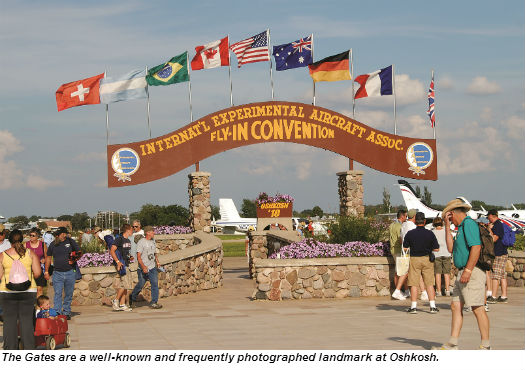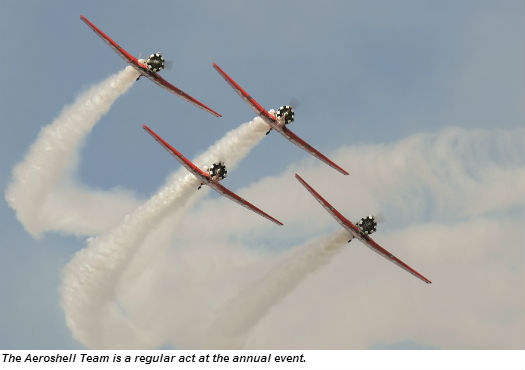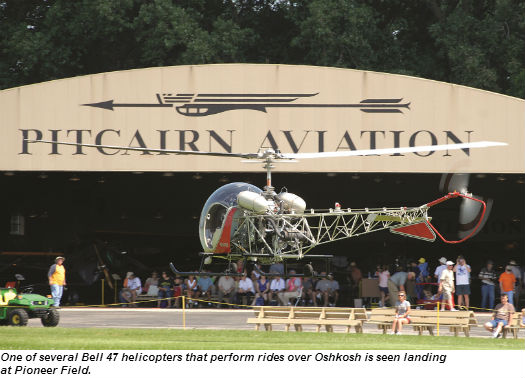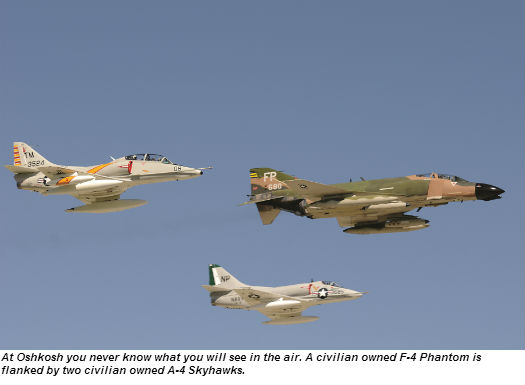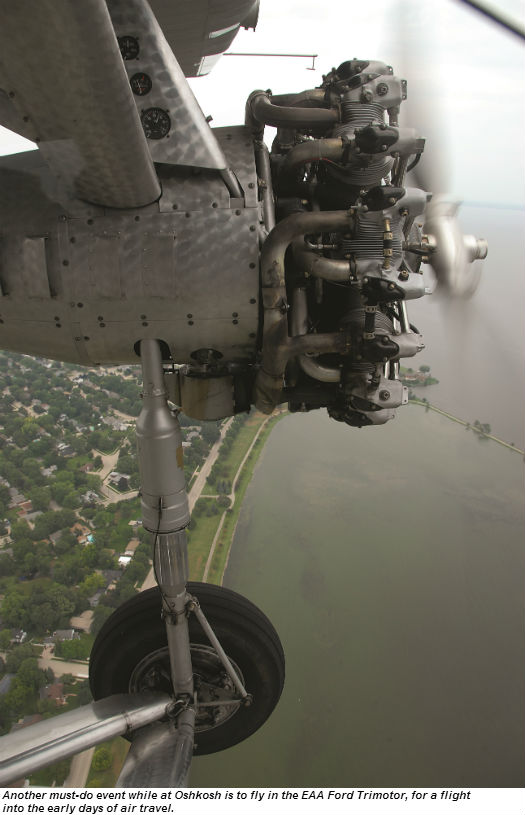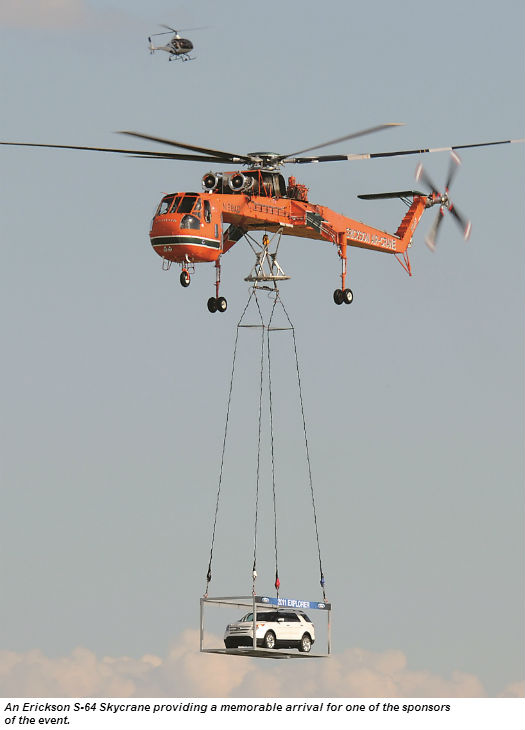In September 1953, a small group of general aviation enthusiasts gathered in Milwaukee, Wis., for the first Experimental Aircraft Association (EAA) fly-in. Groups congregated near 24 airplanes, mostly homebuilt and modified, to chat about all things aviation.
Fewer than 150 people registered as visitors for that fly-in, at what is now known as Timmerfield Field. But that small group planted a seed that has grown into a worldwide aviation phenomenon many simply call “Oshkosh.”
Today, EAA AirVenture Oshkosh attracts more than 500,000 visitors and 10,000 airplanes annually, making the Oshkosh control tower the world’s busiest for one week of the year. The rest of the numbers tell the entire story, however, of AirVenture’s true size and impact. In 2013, AirVenture had 821 commercial exhibitors; 2,115 international visitors from 64 nations; more than 36,000 campers; and 914 media representatives on site from five continents.
The first EAA fly-in was just a small part of the Milwaukee Air Pageant, an air show that disappeared a couple of years later, said Dick Knapinski, EAA senior communications adviser. The air show officials had called EAA founder Paul Poberezny and asked if he could bring some of his club’s airplanes in to display. “It was a social thing as much as anything else,” Knapinski said.
But what happened at that first fly-in would have a major impact on the organization. “Paul often talked about the morning after that first gathering, where he spent the greater part of the day picking up chicken bones, paper cups and everything else,” added Knapinski. “Right then, Paul determined that he would assemble a volunteer corps.…”
That volunteer corps has become the backbone of today’s event.
Wes Schmid of Wauwatosa, Wis., is one of EAA’s first volunteers. He recalls seeing a story about Poberezny in the newspaper, calling him up, and being invited to EAA’s office, then located in the basement of Poberezny’s home. “I walked out of the house with my arms full of stuff to work on for the magazine, and I’m still doing volunteer work,” he said, laughing.
Schmid’s volunteerism extended to the EAA fly-in, where he served as forums chairman for many years.
The 92-year-old has attended every EAA fly-in since 1956 in Milwaukee. For anyone who liked airplanes, and particularly antique or vintage planes, the Milwaukee fly-in was special, remembered Schmid. “It was just a wonderful era. Everybody knew everybody.… and everyone had a good time.”
One of his favourite memories from that period revolves around EAA’s founder. “Paul was running around because he was in charge of everything. But when he was going somewhere to get something, he saw a small boy standing on his tiptoes, trying to look into the cockpit of a plane,” Schmid recalled.
Poberezny stopped and went over to the boy. “He lifted him up so he could see inside,” Schmid said. “It was above and beyond what most people will do, and that has always stuck with me.”
The popularity of the Milwaukee fly-in grew so quickly that it soon needed more space than the area of Wright-Curtiss Field it was allowed to use. By 1959, the event moved to the Rockford Municipal Airport in Illinois. “For the next decade, the growth of Rockford reflected the organization,” said Knapinski. “It was still primarily people who built and restored their own aircraft, but it became much larger.”
Vintage and warbird aircraft numbers increased, and the afternoon air show, organized forums and a limited number of exhibitors became staples of the event. “It became more than just a fly-in gathering,” added Knapinski. “It started to become an aviation event.”
Schmid recalls that era of the fly-in, too. At Rockford, his favorite memories revolve around what happened after activities were over for the day. “We’d go to the motel, shower and eat, and then meet in the hall. Somebody would have a guitar and we’d sing.… It was always so enjoyable.”
Attendance continued to increase in Rockford, and by the mid-60s, EAA moved its fly-in across the airport where there was more room. But soon, even that wasn’t enough space. By 1969, with between 50,000 to 75,000 in attendance yearly, the fly-in had grown to a point where it needed additional facilities. With Rockford’s active commercial aviation business, there was no room for EAA.
So Poberezny again started looking for a new home for the fly-in. Steve Wittman, who had been an EAA member since the association’s founding in 1953 and who served as Winnebago County’s airport manager from 1931-69, suggested the Oshkosh airport, noting there was enough acreage to handle the annual influx of planes, vehicles and tents. But its runways also made Oshkosh the right choice. With two runways—east/west and north/south—it allowed for greater traffic movement.
They put together a proposal, and in late 1969, went before the Winnebago County Board, which gave its approval.
“There was nothing here but farm fields and houses,” said Knapinski. But that didn’t deter Poberezny, his family and a growing number of volunteers. They graded out areas, picked up rocks, and built a few temporary buildings on skids.
Schmid was one of those volunteers who helped prepare for the move to Oshkosh in 1970. “I picked up a lot of stones,” he recalled. But he also put up fences, cut grass, or did anything that needed to be done.
“It became almost automatic,” he said. “Every year you’d go to Oshkosh and do the same thing over and over again.”
That volunteer spirit still exists today, as more than 5,000 people annually donate more than 180,000 hours to help prepare and coordinate the convention’s grounds and activities.
The early Oshkosh conventions were held only on airport grounds. As attendance grew, however, EAA started to lease land from farmers for parking and other uses. Then, in 1980, the EAA Board of Directors voted to make Oshkosh the permanent home for its headquarters, museum and fly-in.
“Up to that point, the headquarters was still in the Milwaukee area, so every summer they had to pack it all up for two or three months, hold the fly-in, and then pack everything up and go back to Milwaukee,” said Knapinski. EAA purchased land, and in 1983, the EAA Aviation Center and the EAA AirVenture Museum opened.
During this period, EAA also constructed new exhibit buildings and Theater in the Woods, a place for its nightly programs; added taxiways with “fingers” so display aircraft had a place to park; and developed Camp Scholler, a campground that annually becomes home to 35,000-plus campers in 10,000 to 12,000 camping units.
In the early 70s, Poberezny wrote to every major airplane manufacturer and invited them to exhibit for free at the growing convention. “But most said we don’t believe there is a marketplace for us at your event,” said Knapinski. However, when Poberezny’s wife, Audrey, came up with the idea of charging for exhibit space, businesses started coming since people equated a fee with more value, he added.
John Monnett was one of the first to realize the importance of exhibiting at Oshkosh. Monnett Experimental Aircraft started exhibiting at the EAA fly-in convention in the mid- 1970s. But in 1981, he became the first (and still the only) businessman to relocate a company to Oshkosh because of EAA.
“In the old days, the whole show was simple and focused on what the core of the organization is, and that is home-building,” Monnett says. “There was one big-top tent for the meetings, and another big-top tent for exhibitors.”
As more businesses realized that AirVenture visitors might be interested in their products, they become more willing to invest in displays. “Twenty-five years ago, if an exhibitor had a 40-by-25 tent, they were living large,” said Knapinski. “But now they are coming with 20,000-square-foot pavilions on permanent slabs.”
Today, Monnett’s current company, Sonex Aircraft LLC, which sells experimental aircraft kits such as Sonex, Waiex and the SubSonex personal jet, has a large outdoor exhibit in “Homebuilder’s Alley” on the convention grounds. “We occupy three booths on a corner, and bring over a movable hangar to use as a sales booth,” explained Monnett. “We’re adjacent to the flight line. Not only do we have our factory airplanes on display, but we can also line up all the customers’ airplanes…”
AirVenture is the only air show at which Monnett still exhibits. Not only is it easier to set up for the show because of Sonex’s proximity to the convention grounds, but it also allows them to offer tours of the company’s nearby three-building campus.
In addition, the Sunday before the show starts, Sonex hosts an open house for its customers. “It’s an important event for us; airplanes that are flying in to be displayed at the show will come here first. Then, later in the afternoon, we have a mass taxi over to the tie-down area.”
Knapinski said manufacturers announce their innovations at Oshkosh because they know both their consumers and the media are there. “There are more than 60 news conferences or media events during the week. That number has tripled in the last 15 years.”
By the 1980s, attendance at the convention jumped into six figures each year, and Oshkosh became known as one of sport aviation’s premier gatherings. 1985 was a key year, however, when the Concorde came for the first time. “At that time, it had only landed at New York, Washington and Miami,” remembered Knapinski. “Suddenly, a little organization in Oshkosh, Wis., had the Concorde landing at Wittman Field, and it was an astounding thing. People came from everywhere to see this.”
As Oshkosh grew in popularity, it also grew in programs and activities. KidVenture was added in 1999, giving children a place to play, build and learn about aviation in a hands-on environment.
To give families more things to do at night, EAA began a Fly-in Theater about 10 years ago, where aviation-themed movies play throughout the week. In 2013, Oshkosh even held a premiere screening of Disney’s “Planes,” bringing in 15,000 people who filled the lawn and surrounding area in front of the five-story high screen.
Concerts were added in 2006 when the Beach Boys performed after the opening day’s air show. A night air show was introduced in 2011, and it became so popular that two night air shows were featured during the seven-day event in 2013.
After EAA AirVenture 2008, the largest site improvement upgrade in the event’s history began. The project, which will be completed in phases over a 10-year period, includes many visitor enhancements.
At the 2009 convention, visitors already saw some of the improvements, from the removal of the former air traffic control tower, to the installation of new pathways to make it easier to get around the grounds, to a new main entrance design and a renewal of the Brown Arch that marks the entry from the flightline.
Other major changes already completed include creating more than 40 wireless Internet hotspots throughout the grounds, adding flush toilets and more showers in the campgrounds, and improving drainage after Oshkosh became “Sloshkosh,” when the city received 10 inches of rain in the 24 days before the 2010 event.
Schmid has many good memories of the four decades the fly-in has been held at Oshkosh. He recalls witnessing breakthroughs in technology, seeing revolutionary airplane designs and listening to people who did amazing things.
Today, AirVenture visitors can learn about the latest aircraft and innovations; discover new ideas and techniques from nearly 1,000 forums and workshops; see aviation’s top personalities; and more. AirVenture 2014, the 62nd annual fly-in convention and the 45th in Oshkosh, will also pay homage to Poberezny, who died in August 2013 at the age of 91.
Knapinski said EAA has always welcomed anyone fascinated by aviation. “Bringing in the Airbus A380, the Concorde or Jetman is an opportunity to bring aviation notables here that people want to see,” he concluded. “People are fascinated by aviation, whether it is a small aircraft or a big one. That diversity is the magic of Oshkosh. You don’t know what you will see. Oshkosh really is aviation’s family reunion. No matter what you like flying, you are welcome here.”
Barbara A. Schmitz is an aviation enthusiast and former newspaper writer and editor who has attended and reported on EAA AirVenture Oshkosh for more than 30 years. She also teaches journalism courses at the University of Wisconsin Oshkosh.

